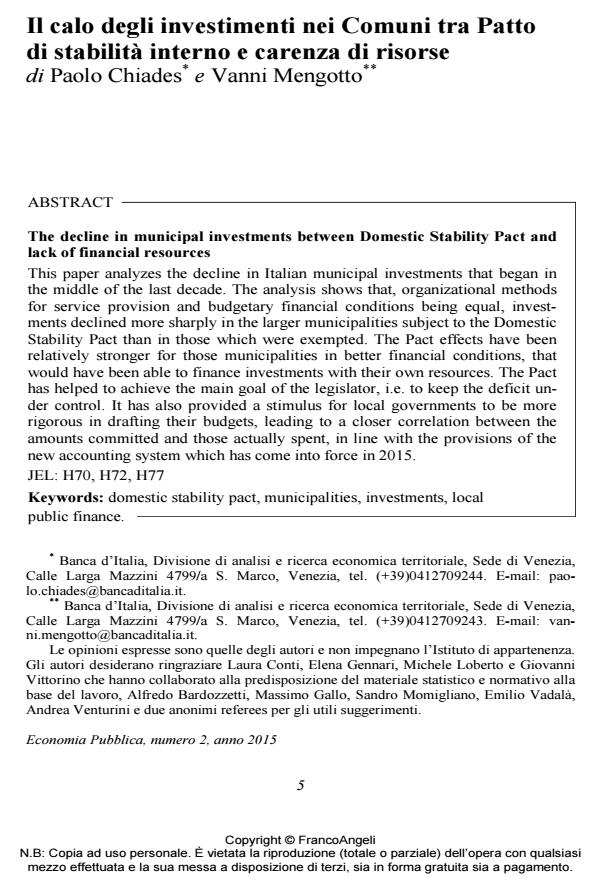Il calo degli investimenti nei Comuni tra Patto di stabilità interno e carenza di risorse
Titolo Rivista ECONOMIA PUBBLICA
Autori/Curatori Paolo Chiades, Vanni Mengotto
Anno di pubblicazione 2016 Fascicolo 2015/2
Lingua Italiano Numero pagine 40 P. 5-44 Dimensione file 491 KB
DOI 10.3280/EP2015-002001
Il DOI è il codice a barre della proprietà intellettuale: per saperne di più
clicca qui
Qui sotto puoi vedere in anteprima la prima pagina di questo articolo.
Se questo articolo ti interessa, lo puoi acquistare (e scaricare in formato pdf) seguendo le facili indicazioni per acquistare il download credit. Acquista Download Credits per scaricare questo Articolo in formato PDF

FrancoAngeli è membro della Publishers International Linking Association, Inc (PILA)associazione indipendente e non profit per facilitare (attraverso i servizi tecnologici implementati da CrossRef.org) l’accesso degli studiosi ai contenuti digitali nelle pubblicazioni professionali e scientifiche
This paper analyzes the decline in Italian municipal investments that began in the middle of the last decade. The analysis shows that, organizational methods for service provision and budgetary financial conditions being equal, investments declined more sharply in the larger municipalities subject to the Domestic Stability Pact than in those which were exempted. The Pact effects have been relatively stronger for those municipalities in better financial conditions, that would have been able to finance investments with their own resources. The Pact has helped to achieve the main goal of the legislator, i.e. to keep the deficit under control. It has also provided a stimulus for local governments to be more rigorous in drafting their budgets, leading to a closer correlation between the amounts committed and those actually spent, in line with the provisions of the new accounting system which has come into force in 2015.
Parole chiave:Domestic stability pact, municipalities, investments, local public finance
Jel codes:H70, H72, H77
- From Containment to Rationalization: Increasing Public Expenditure Efficiency in France Jean-Jacques Hallaert, Maximilien Queyranne, in SSRN Electronic Journal /2016
DOI: 10.2139/ssrn.2720389 - Mercato Immobiliare, Imprese Della Filiera E Credito: Una Valutazione Degli Effetti Della Lunga Recessione (The Real Estate Market, the Supply Chain and Credit: The Effects of the Great Recession) Cristina Fabrizi, Raffaella Pico, Luca Casolaro, Mariano Graziano, Elisabetta Manzoli, Sonia Soncin, Luciano Esposito, Giuseppe Saporito, Tiziana Sodano, in SSRN Electronic Journal /2015
DOI: 10.2139/ssrn.2609279 - An Evaluation of the Policies on Repayment of Government's Trade Debt in Italy Leandro D'Aurizio, Domenico Depalo, in SSRN Electronic Journal /2016
DOI: 10.2139/ssrn.2856378 - Corruption under Austerity Gianmarco Daniele, Tommaso Giommoni, in SSRN Electronic Journal /2020
DOI: 10.2139/ssrn.3531683 - Intergovernmental Transfers and Expenditure Arrears Paolo Chiades, Luciano G. Greco, Vanni Mengotto, Luigi Moretti, Paola Valbonesi, in SSRN Electronic Journal /2016
DOI: 10.2139/ssrn.2867452 - Why Does Social Capital Increase Government Performance? The Role of Local Elections across Italian Municipalities Alberto Batinti, Luca Andriani, Andrea Filippetti, in SSRN Electronic Journal /2017
DOI: 10.2139/ssrn.2995833 - Municipal Finance in Southern Italy: Structural Criticalities and the Effects of the Pandemic Crisis Alfredo Bardozzetti, Paolo Chiades, Anna Laura Mancini, Vanni Mengotto, Giacomo Ziglio, in Italian Economic Journal /2024 pp.1233
DOI: 10.1007/s40797-024-00288-0 - Putting Tradition into Practice: Heritage, Place and Design Guglielmo Minervino, Valentino Canturi, pp.1303 (ISBN:978-3-319-57936-8)
- Political Budget Cycles with Informed Voters: Evidence from Italy Luca Repetto, in The Economic Journal /2018 pp.3320
DOI: 10.1111/ecoj.12570
Paolo Chiades, Vanni Mengotto, Il calo degli investimenti nei Comuni tra Patto di stabilità interno e carenza di risorse in "ECONOMIA PUBBLICA " 2/2015, pp 5-44, DOI: 10.3280/EP2015-002001